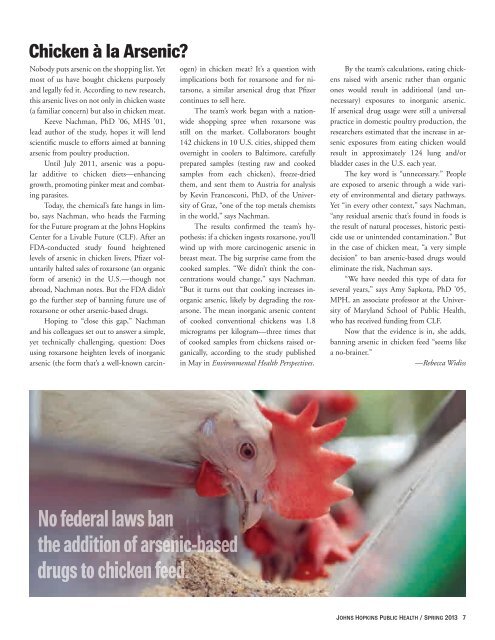this is global health
Download Low Resolution PDF - Johns Hopkins Public Health ...
Download Low Resolution PDF - Johns Hopkins Public Health ...
Create successful ePaper yourself
Turn your PDF publications into a flip-book with our unique Google optimized e-Paper software.
Chicken à la Arsenic?<br />
Nobody puts arsenic on the shopping l<strong>is</strong>t. Yet<br />
most of us have bought chickens purposely<br />
and legally fed it. According to new research,<br />
<strong>th<strong>is</strong></strong> arsenic lives on not only in chicken waste<br />
(a familiar concern) but also in chicken meat.<br />
Keeve Nachman, PhD ’06, MHS ’01,<br />
lead author of the study, hopes it will lend<br />
scientific muscle to efforts aimed at banning<br />
arsenic from poultry production.<br />
Until July 2011, arsenic was a popular<br />
additive to chicken diets—enhancing<br />
growth, promoting pinker meat and combating<br />
parasites.<br />
Today, the chemical’s fate hangs in limbo,<br />
says Nachman, who heads the Farming<br />
for the Future program at the Johns Hopkins<br />
Center for a Livable Future (CLF). After an<br />
FDA-conducted study found heightened<br />
levels of arsenic in chicken livers, Pfizer voluntarily<br />
halted sales of roxarsone (an organic<br />
form of arsenic) in the U.S.—though not<br />
abroad, Nachman notes. But the FDA didn’t<br />
go the further step of banning future use of<br />
roxarsone or other arsenic-based drugs.<br />
Hoping to “close <strong>th<strong>is</strong></strong> gap,” Nachman<br />
and h<strong>is</strong> colleagues set out to answer a simple,<br />
yet technically challenging, question: Does<br />
using roxarsone heighten levels of inorganic<br />
arsenic (the form that’s a well-known carcinogen)<br />
in chicken meat? It’s a question with<br />
implications both for roxarsone and for nitarsone,<br />
a similar arsenical drug that Pfizer<br />
continues to sell here.<br />
The team’s work began with a nationwide<br />
shopping spree when roxarsone was<br />
still on the market. Collaborators bought<br />
142 chickens in 10 U.S. cities, shipped them<br />
overnight in coolers to Baltimore, carefully<br />
prepared samples (testing raw and cooked<br />
samples from each chicken), freeze-dried<br />
them, and sent them to Austria for analys<strong>is</strong><br />
by Kevin Francesconi, PhD, of the University<br />
of Graz, “one of the top metals chem<strong>is</strong>ts<br />
in the world,” says Nachman.<br />
The results confirmed the team’s hypothes<strong>is</strong>:<br />
if a chicken ingests roxarsone, you’ll<br />
wind up with more carcinogenic arsenic in<br />
breast meat. The big surpr<strong>is</strong>e came from the<br />
cooked samples. “We didn’t think the concentrations<br />
would change,” says Nachman.<br />
“But it turns out that cooking increases inorganic<br />
arsenic, likely by degrading the roxarsone.<br />
The mean inorganic arsenic content<br />
of cooked conventional chickens was 1.8<br />
micrograms per kilogram—three times that<br />
of cooked samples from chickens ra<strong>is</strong>ed organically,<br />
according to the study publ<strong>is</strong>hed<br />
in May in Environmental Health Perspectives.<br />
By the team’s calculations, eating chickens<br />
ra<strong>is</strong>ed with arsenic rather than organic<br />
ones would result in additional (and unnecessary)<br />
exposures to inorganic arsenic.<br />
If arsenical drug usage were still a universal<br />
practice in domestic poultry production, the<br />
researchers estimated that the increase in arsenic<br />
exposures from eating chicken would<br />
result in approximately 124 lung and/or<br />
bladder cases in the U.S. each year.<br />
The key word <strong>is</strong> “unnecessary.” People<br />
are exposed to arsenic through a wide variety<br />
of environmental and dietary pathways.<br />
Yet “in every other context,” says Nachman,<br />
“any residual arsenic that’s found in foods <strong>is</strong><br />
the result of natural processes, h<strong>is</strong>toric pesticide<br />
use or unintended contamination.” But<br />
in the case of chicken meat, “a very simple<br />
dec<strong>is</strong>ion” to ban arsenic-based drugs would<br />
eliminate the r<strong>is</strong>k, Nachman says.<br />
“We have needed <strong>th<strong>is</strong></strong> type of data for<br />
several years,” says Amy Sapkota, PhD ’05,<br />
MPH, an associate professor at the University<br />
of Maryland School of Public Health,<br />
who has received funding from CLF.<br />
Now that the evidence <strong>is</strong> in, she adds,<br />
banning arsenic in chicken feed “seems like<br />
a no-brainer.”<br />
—Rebecca Wid<strong>is</strong>s<br />
chr<strong>is</strong> hartlove<br />
No federal laws ban<br />
the addition of arsenic-based<br />
drugs to chicken feed.<br />
JOhns hOpkins public healTh / spRing 2013 7


